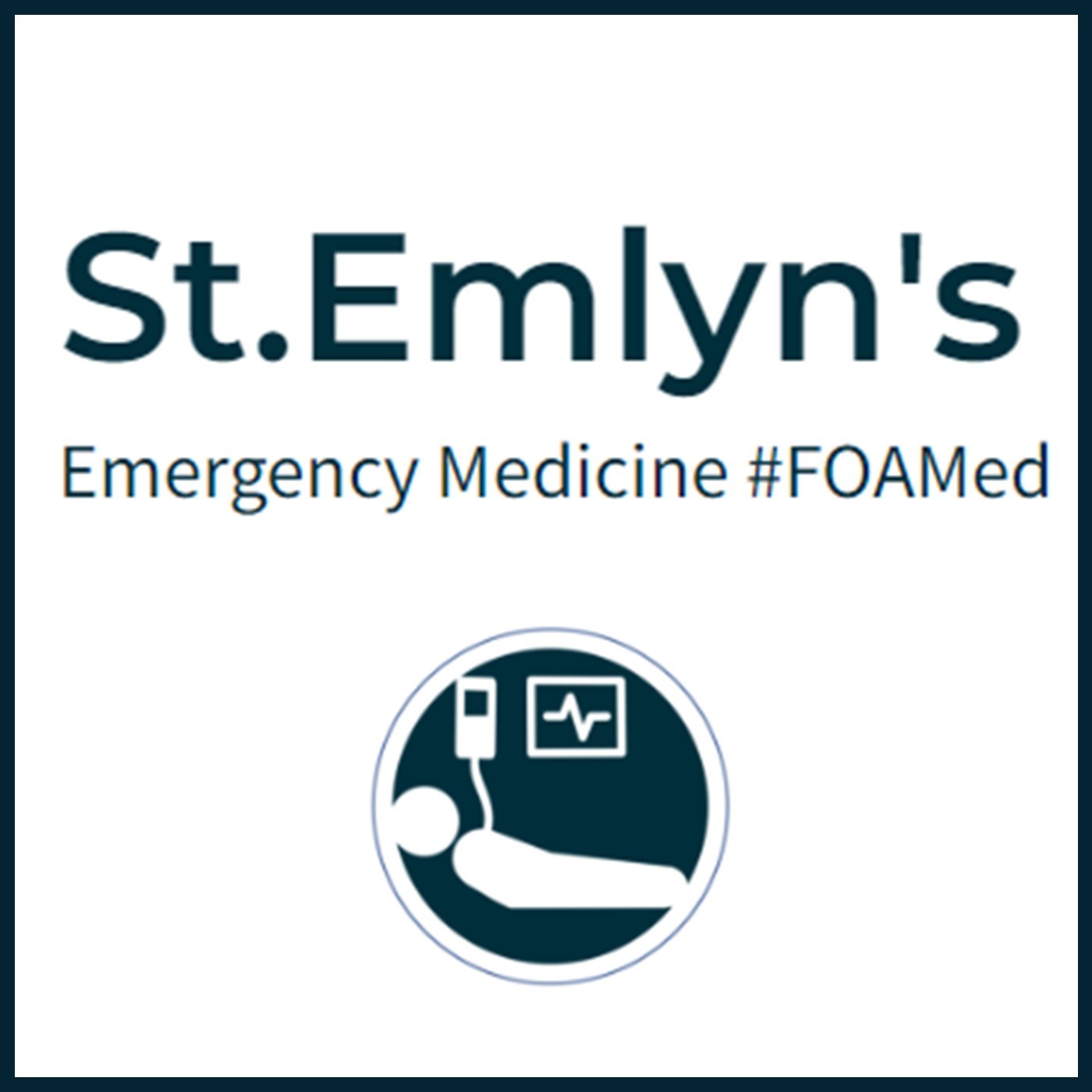
1.3M
Downloads
274
Episodes
A UK based Emergency Medicine podcast for anyone who works in emergency care. The St Emlyn ’s team are all passionate educators and clinicians who strive to bring you the best evidence based education. Our four pillars of learning are evidence-based medicine, clinical excellence, personal development and the philosophical overview of emergency care. We have a strong academic faculty and reputation for high quality education presented through multimedia platforms and articles. St Emlyn’s is a name given to a fictionalised emergency care system. This online clinical space is designed to allow clinical care to be discussed without compromising the safety or confidentiality of patients or clinicians.
Episodes

Sunday Aug 03, 2014
Ep 13 - Intro to EM: Shortness of breath
Sunday Aug 03, 2014
Sunday Aug 03, 2014
Shortness of breath, or dyspnoea, is an alarming symptom because it can signify a wide range of serious conditions. From acute respiratory diseases to cardiac emergencies, the differential diagnosis is vast. For new doctors, encountering a patient with dyspnea can be particularly challenging due to the multitude of potential causes and the urgent nature of the symptom.
Prioritising Life-Threatening Conditions
In the ED, our primary focus is to rule out the most serious conditions first. This approach ensures that we address potentially fatal diagnoses promptly. The key life-threatening causes of shortness of breath include:
- Asthma and COPD Exacerbations
- Pneumonia
- Left Ventricular Failure (LVF)
- Pulmonary Embolism (PE)
- Pneumothorax
These conditions require immediate attention and demand different management strategies. Let's break down each one and discuss the clinical approach.
Initial Stabilisation: Oxygen Therapy
When a patient presents with shortness of breath, one of the first steps is to administer oxygen. This intervention is typically beneficial, as it addresses potential hypoxia, a common denominator in many serious conditions. While long-term oxygen therapy may have contraindications in specific situations, such as COPD exacerbations, the immediate goal is to stabilize the patient.
Resuscitation and Monitoring
For patients with severe dyspnea, resuscitation measures might be necessary. These individuals should be placed in a monitored area with nursing support and close physician oversight. In cases where respiratory distress is evident, ensure that resuscitation equipment and personnel are readily available.
Taking a Detailed History and Performing a Physical Examination
History Taking
A thorough history is critical in identifying the underlying cause of shortness of breath. Key aspects to explore include:
- Past Medical History: Conditions such as asthma, COPD, heart failure, or previous PE episodes are crucial.
- Symptom Onset and Progression: Sudden onset may suggest PE or pneumothorax, while a more gradual progression could indicate chronic diseases.
- Associated Symptoms: Fever might point towards an infectious process like pneumonia, while chest pain could suggest PE or myocardial infarction.
It's also helpful to ask the patient if they have experienced similar symptoms before. This question can provide immediate insight, especially if the patient has a known condition like LVF.
Physical Examination
The physical examination should be comprehensive, focusing on:
- Respiratory Rate: Tachypnea is a red flag and often correlates with the severity of the underlying condition.
- Heart and Lung Sounds: Wheezing, crackles, or diminished breath sounds can help differentiate between asthma, COPD, pneumonia, and heart failure.
- Peripheral Signs: Look for indications of DVT, cyanosis, or edema, which can suggest cardiac or thromboembolic etiologies.
Diagnostic Testing and Imaging
Initial Tests
- Electrocardiogram (ECG): Essential for detecting cardiac causes such as ischemia or arrhythmias.
- Chest X-Ray: A quick and non-invasive tool to identify pneumonia, pneumothorax, heart failure, or pleural effusions.
- Arterial Blood Gas (ABG): Useful for assessing oxygenation and ventilation status, particularly in acute cases. Using local anesthetic can alleviate the discomfort associated with ABG sampling.
Advanced Imaging
- CT Pulmonary Angiography (CTPA): The gold standard for diagnosing PE, particularly when clinical suspicion is high.
- Point-of-Care Ultrasound (POCUS): Increasingly used to evaluate lung pathology, assess for pleural effusions, and gauge cardiac function.
Tailoring Treatment to Specific Diagnoses
Asthma and COPD Exacerbations
- Bronchodilators: Administer via nebulizers or metered-dose inhalers with spacers.
- Corticosteroids: Often necessary to reduce airway inflammation.
Pneumonia
- Antibiotics: Initiate early, especially in septic patients, to combat bacterial infections.
- Supportive Care: Including fluids for hydration and fever management.
Left Ventricular Failure
- Diuretics: Administer to reduce fluid overload and alleviate pulmonary congestion.
- Vasodilators: Consider in cases of severe hypertension or acute pulmonary edema.
Pulmonary Embolism
- Anticoagulation: Essential for preventing further clot formation.
- Thrombolysis: Consider in cases of massive PE with hemodynamic instability.
Pneumothorax
- Needle Decompression: Required for tension pneumothorax, followed by chest tube insertion.
- Observation or Chest Tube: Depending on the size and symptoms of a simple pneumothorax.
Monitoring and Reassessment
Continuous monitoring is vital for patients presenting with shortness of breath. Vital signs, including oxygen saturation and respiratory rate, should be closely observed. Frequent reassessment allows for timely adjustments in the treatment plan, ensuring optimal patient outcomes.
The Importance of Senior Support and Collaborative Care
In the ED, working alongside senior colleagues and consulting other specialties can significantly enhance patient care. Junior doctors should proactively seek guidance, especially in complex or uncertain cases. This collaborative approach not only enhances patient safety but also serves as a valuable educational experience.
Developing a Systematic Approach
Dealing with shortness of breath can be stressful, especially when the cause is not immediately apparent. Developing a systematic approach, or mental model, can help clinicians efficiently manage these cases. Practicing this approach mentally, perhaps during a commute, can prepare one for real-life scenarios. This mental rehearsal fosters a more confident and effective response when faced with an actual patient.
Conclusion
Shortness of breath is a common yet potentially life-threatening symptom that demands a structured and thorough approach. By prioritizing the exclusion of critical diagnoses, employing appropriate diagnostic tools, and initiating targeted treatments, emergency physicians can significantly improve patient outcomes. Remember, early intervention and continuous monitoring are key, as is the willingness to consult senior colleagues and use available resources.
For more detailed discussions and educational resources, visit our blog site. Keep learning, stay curious, and continue to provide compassionate care to all patients. Thank you for joining us on the St. Emlyn's podcast. We look forward to sharing more insights and discussions in future episodes. Good luck in your practice, and always strive to heal the sick! See you soon!
Summary
Shortness of breath is a common yet potentially life-threatening presentation in the emergency department. A structured approach to assessment and management, including a thorough primary survey, focused history, physical examination, and targeted investigations, is essential. Early initiation of oxygen therapy, appropriate use of diagnostic tools, and timely management of underlying conditions can significantly impact patient outcomes. Collaboration with senior colleagues and continuous education through simulation and practice are key to improving care for these patients.
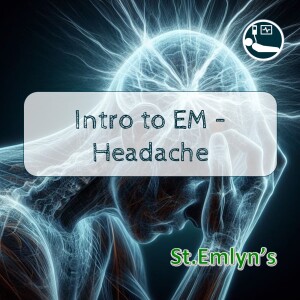
Friday Aug 01, 2014
Ep 12 - Intro to EM: Headache
Friday Aug 01, 2014
Friday Aug 01, 2014
The Importance of Thorough Evaluation
Headaches can be tricky. Many patients experience them as part of various symptomatologies, but our focus here is on those for whom headache is the primary complaint. Our objective is to rule out serious conditions while providing effective management. The major diagnoses to consider include subarachnoid haemorrhage, meningitis, brain tumours, and temporal arteritis.
Subarachnoid Hemorrhage: A Critical Diagnosis
Every emergency physician must be vigilant about subarachnoid haemorrhage (SAH). The classic presentation is a sudden-onset severe headache, often described as being hit on the back of the head with a baseball bat. However, not all patients present with this textbook description. Many just report an incredibly severe headache, sometimes developing over minutes rather than instantaneously.
In such cases, the threshold for investigation should be low. Studies indicate that about 10% of patients presenting to the ED with headaches have a potentially life-threatening condition such as SAH, tumor, or meningitis. This high hit rate underscores the importance of being thorough. Early CT scans are critical. They are more diagnostic the earlier they are performed, and a negative CT can often effectively rule out SAH.
Meningitis: A Subtle but Deadly Threat
Meningitis is another serious condition that can cause a headache. The classic signs include a recent infection, high temperature, neck stiffness, and altered consciousness. However, like SAH, meningitis doesn’t always follow the textbook. Patients may present with milder symptoms, such as neck pain without severe rigidity or general discomfort with light without pronounced photophobia.
Blood tests like white cell count and CRP are not always reliable when considering meningitis. The absence of abnormalities doesn’t rule out the disease. Therefore, empirical treatment with antibiotics is often warranted if there’s any suspicion of meningitis. It’s better to administer antibiotics and later find out they weren’t necessary than to miss a diagnosis and face dire consequences.
Brain Tumors: The Silent Intruders
Brain tumours can present subtly, often with non-specific signs like headaches, which can be easily overlooked. First-time seizures in young adults are a common presentation that warrants a thorough evaluation for tumours. CT scans are typically sufficient to detect most tumours, although in some cases, additional imaging such as MRI or CT angiography may be necessary.
Temporal Arteritis: A Vision-Saving Diagnosis
Temporal arteritis is another condition to consider, particularly in patients over 50. Symptoms include headache, jaw claudication, and visual disturbances. Blood tests such as ESR and CRP are useful here. Early treatment with steroids can prevent irreversible vision loss, making prompt diagnosis and intervention crucial.
Managing Migraines in the ED
Migraines are a common yet often overlooked cause of severe headaches that bring patients to the ED. While not life-threatening, they can be debilitating. Effective management involves hydration, analgesics, anti-emetics, and sometimes 5HT3 receptor antagonists. It’s important to distinguish between first-time migraine presentations and recurrent migraines, especially in older patients, to rule out more serious underlying conditions.
The Role of CT Scans in Headache Management
The advent of CT scanning has revolutionized the management of headaches in the ED. Today, the threshold for performing a CT scan is much lower than it was 15 years ago. Despite concerns about radiation, the benefit of identifying serious conditions outweighs the risks, particularly when about 10% of patients have significant pathology.
Practical Tips for Junior Doctors
For junior doctors, it’s essential to involve senior colleagues in the evaluation and management of patients presenting with headaches. Discussing cases with experienced physicians helps in understanding the rationale behind investigations and management decisions. This collaborative approach ensures comprehensive care and aids in professional development.
Conclusion
Managing headaches in the emergency department requires a careful, systematic approach to rule out life-threatening conditions while providing effective symptom relief. Subarachnoid haemorrhage, meningitis, brain tumours, and temporal arteritis are critical diagnoses that must not be missed. Early CT scans, judicious use of blood tests, and prompt empirical treatment when necessary are key strategies. Remember, thorough evaluation and timely intervention can significantly improve patient outcomes.
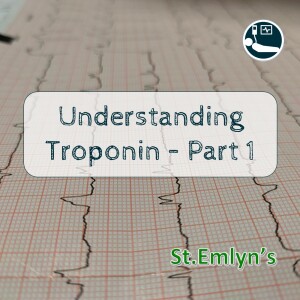
Sunday Jul 27, 2014
Ep - 11 Understanding Troponin Part 1
Sunday Jul 27, 2014
Sunday Jul 27, 2014
The Ultimate Guide to Understanding Troponins in Emergency Medicine
Welcome to the St. Emlyn's podcast! In this episode, we're exploring the fascinating world of troponins, vital biomarkers essential for diagnosing myocardial injury. Whether you're a seasoned clinician or a medical student, understanding troponins is crucial for effective patient care. We'll cover everything from the basics to advanced concepts, ensuring you have a comprehensive grasp of this critical topic.
What are Troponins?
Troponins are proteins found in muscle tissue, playing a key role in muscle contraction. Often misunderstood as cardiac enzymes, troponins are actually proteins involved in the contractile apparatus within muscle cells. They exist in three forms: Troponin I, Troponin T, and Troponin C, which work together within muscle fibers to regulate muscle contractions.
Why are Troponins Important in Cardiology?
Troponins are crucial biomarkers for diagnosing myocardial injury. When heart muscle is damaged, troponins are released into the bloodstream. This release can occur due to various conditions, including myocardial infarction (heart attack) and other forms of stress on the heart. Measuring troponin levels in the blood helps clinicians determine the extent of myocardial injury and make informed decisions about patient care.
The Difference Between Cardiac and Skeletal Troponins
Troponins are present in both skeletal and cardiac muscle. However, cardiac-specific isoforms of Troponin I and Troponin T can be detected through blood tests, allowing clinicians to specifically identify myocardial damage. This specificity is a significant advancement over previous markers like CK, LDH, and ALT, which were not cardiac-specific and took longer to rise in the bloodstream.
When are Troponins Released into the Blood?
Troponins are released into the bloodstream when there is myocardial injury. This injury can result from various causes, such as acute myocardial infarction, physical stress, or other conditions that strain the heart. Understanding that troponins indicate myocardial injury rather than just myocardial infarction is crucial for accurate diagnosis and treatment.
The Kinetics of Troponin Release
Following myocardial injury, troponin levels typically peak in the blood within 12 to 24 hours. The time it takes for troponin levels to fall depends on several factors, including the severity of the injury, the patient's renal function, and whether there is ongoing troponin release into the blood. For example, patients with significant myocardial infarction might take weeks to clear troponins from their bloodstream, while those with smaller injuries might clear them within a day.
Troponins and Renal Failure
A common question is whether troponin tests are useful in patients with renal failure. The answer is a resounding yes. Although patients with renal failure may have elevated baseline troponin levels due to reduced clearance, troponin testing remains a valuable diagnostic tool. It's essential to interpret these levels in the context of the patient's renal function and look for trends in troponin levels through serial testing.
Understanding Troponin Assays
Troponin tests are immunoassays, which means they use antibodies to target specific parts of the troponin molecule. These antibodies are attached to a signal that emits light, allowing for the quantification of troponin levels in the blood. While lab-based assays are highly accurate, point-of-care testing devices are also available, though they may not be as sensitive or precise as lab tests.
The Role of Point-of-Care Testing
Point-of-care testing devices, such as handheld analyzers, offer quick results and can be used at the bedside. However, they may not match the sensitivity and precision of lab-based assays. Some portable devices provide qualitative results, similar to a home pregnancy test, while others offer quantitative measurements. Clinicians should be aware of these differences and use point-of-care devices appropriately.
Analytical vs. Diagnostic Sensitivity
When discussing troponin assays, it's crucial to differentiate between analytical sensitivity and diagnostic sensitivity. Analytical sensitivity refers to the assay's ability to detect low concentrations of troponin reliably. In contrast, diagnostic sensitivity pertains to the assay's ability to correctly identify patients with the condition being tested for, such as acute myocardial infarction. High-sensitivity troponin assays have improved both analytical and diagnostic sensitivity, enabling earlier and more accurate diagnosis.
Timing of Troponin Testing
In the UK, troponin testing typically starts from the time of symptom onset. This approach differs from other countries where testing begins upon the patient's arrival in the emergency department. The timing of troponin testing is crucial, as early testing can lack sensitivity. Serial sampling over several hours helps ensure accurate diagnosis, with a common practice being to test initially and then again at intervals such as six, ten, or twelve hours after symptom onset.
Interpreting Troponin Levels in Clinical Practice
Interpreting troponin levels requires considering the clinical context and pre-test probability. A positive troponin test in a patient with low pre-test probability of myocardial infarction may not indicate a true positive. Conversely, a negative test in a high-risk patient does not entirely rule out disease, especially if there is potential for a late troponin rise. Clinicians must integrate troponin results with other diagnostic information to make informed decisions.
Troponins in Renal Failure
Patients with renal failure often have elevated baseline troponin levels due to impaired clearance. However, troponin testing remains valuable for diagnosing myocardial injury in these patients. It's essential to understand the baseline level for each patient and focus on changes in troponin levels over time, rather than a single measurement. Serial sampling helps differentiate chronic elevation from acute myocardial injury.
Diagnosing Unstable Angina
It's important to recognize that unstable angina can occur without elevated troponin levels. These patients may not show a rise and fall in troponin but still have significant coronary artery disease that requires attention. Clinical judgment, along with other diagnostic tools like ECG and patient history, is vital in diagnosing and managing unstable angina.
Key Takeaways for Clinicians
- Troponins are proteins involved in muscle contraction and are critical biomarkers for diagnosing myocardial injury.
- Cardiac-specific isoforms of Troponin I and Troponin T are used to detect myocardial damage through blood tests.
- Troponins are released into the blood following myocardial injury, not just myocardial infarction.
- The timing of troponin testing is crucial, with serial sampling providing more accurate results.
- Point-of-care testing devices offer quick results but may lack the sensitivity and precision of lab-based assays.
- Interpreting troponin levels requires considering the clinical context and pre-test probability.
- Troponin testing is valuable in patients with renal failure, focusing on changes in levels over time.
- Unstable angina can occur without elevated troponin levels, requiring careful clinical evaluation.
Conclusion
Understanding troponins and their role in diagnosing myocardial injury is essential for clinicians. From the basics of what troponins are to the nuances of interpreting test results, this knowledge is crucial for providing the best care to patients with suspected cardiac conditions. Stay tuned for our next episode, where we'll delve deeper into high-sensitivity troponin assays and their impact on emergency medicine.
For any questions or further discussion, feel free to comment on the blog post or email us. We're here to help and look forward to continuing this conversation. Until next time, take care and keep learning!
This blog post is brought to you by the team at St. Emlyn's, dedicated to providing high-quality education and resources for emergency medicine professionals.

Sunday Jun 29, 2014
Ep 7 - Delving into the Number Needed To Treat, RRR and ARR.
Sunday Jun 29, 2014
Sunday Jun 29, 2014
Understanding Relative Risk, Absolute Risk, and Number Needed to Treat: A Guide for Emergency Medicine
Welcome back to the St. Emlyn’s podcast. I’m Iain Beardsell and joining me is Simon Carley. Today, we’re delving into the complex yet critical concepts of relative risk, absolute risk, and the number needed to treat (NNT) in the context of emergency medicine. These metrics are essential for understanding the effectiveness of treatments and making informed decisions in clinical practice.
The Importance of Understanding Risk Metrics
In emergency medicine, it’s vital to comprehend how different treatments impact patient outcomes. This understanding not only helps in communicating with patients but also aids in making better clinical decisions. Two key terms frequently encountered are relative risk reduction and absolute risk reduction.
Relative Risk Reduction vs. Absolute Risk Reduction
Imagine we are conducting a trial on a new drug for myocardial infarction (AMI) patients. Typically, 10% of AMI patients die within a month. If our new treatment claims a 50% relative risk reduction, it sounds impressive. However, understanding what this actually means is crucial. A 50% relative risk reduction translates to reducing the death rate from 10% to 5%. While this is significant, it's essential to recognize the difference between relative and absolute risk reduction.
Calculating the Number Needed to Treat (NNT)
The NNT is a valuable metric for understanding how many patients need to receive a particular treatment to prevent one additional adverse outcome. It’s derived from the absolute risk reduction. For instance, if a treatment reduces mortality from 10% to 5%, the absolute risk reduction is 5%. To calculate the NNT, divide 100 by the absolute risk reduction percentage. In this case, 100 divided by 5 equals an NNT of 20. This means we need to treat 20 patients to save one life.
Examples of NNT in Practice
Let’s consider some real-world examples. Tranexamic acid in trauma has an NNT of around 50, meaning we need to treat 50 patients to save one life. For aspirin in treating myocardial infarction, the NNT is also around 50. These figures highlight the effectiveness of these treatments in clinical practice.
Balancing Benefits and Harms
Understanding NNT is crucial, but it’s equally important to consider the number needed to harm (NNH). This metric indicates how many patients need to receive a treatment before one adverse effect occurs. For example, in trials involving starch solutions for sepsis, the NNH was found to be around 10-16. This means for every 10 to 16 patients treated, one additional death occurred. Balancing the benefits and harms is essential for making informed clinical decisions.
Example: Stroke Thrombolysis
In stroke thrombolysis, the NNT is around 8, meaning one in eight patients benefits from the treatment. However, the NNH is about 16, indicating one in 16 patients might experience a harmful outcome, such as intracerebral hemorrhage. Communicating these risks and benefits to patients is crucial for informed consent and shared decision-making.
The Role of Natural Frequencies
Using natural frequencies, such as “one in 100 people” or “one in 50 people,” helps in explaining risks and benefits in a more understandable way. For instance, saying “one in 100 people in your neighborhood” or “one person in a packed football stadium” can make the statistics more relatable.
Misdiagnosis and Its Impact
A key takeaway is that not every missed diagnosis leads to adverse outcomes. Often, treatments may have minimal benefit, and in some cases, they could cause harm. For example, the rush to administer clopidogrel in acute myocardial infarction might not always be necessary, given its relatively high NNT.
Applying These Concepts in Clinical Practice
Understanding and applying these concepts can change how we approach patient care. It allows us to prioritize interventions that provide the most significant benefit while minimizing potential harm. It also highlights the importance of taking time to ensure the right diagnosis and treatment, rather than rushing into potentially harmful decisions.
The Number Needed to Educate (NNE)
A fun and thought-provoking concept introduced in our discussion is the Number Needed to Educate (NNE). How many blogs or articles do you need to read before it changes your clinical practice? This metric emphasizes the importance of continuous learning and staying updated with the latest evidence-based practices.
Conclusion
In emergency medicine, understanding relative risk, absolute risk, and NNT is vital for making informed treatment decisions. These metrics help in balancing the benefits and harms of treatments, leading to better patient outcomes. By effectively communicating these risks and benefits to patients, we can ensure shared decision-making and improve overall patient care.
Read more at St Emlyns and on the accompanying blogpost
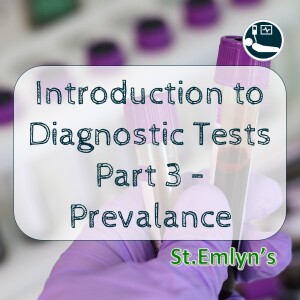
Sunday Jun 22, 2014
Ep 5 - Understanding diagnostics in Emergency Medicine Part 3 - Prevalance
Sunday Jun 22, 2014
Sunday Jun 22, 2014
Exploring Diagnostic Testing in Emergency Medicine: A St Emlyn’s Perspective
Welcome back to the St Emlyn’s podcast! Today, we're diving deep into the world of diagnostic testing in emergency medicine, inspired by a recent discussion featuring our esteemed colleague Rick Boddie. This episode sheds light on the complexities of diagnosis, the probabilities involved, and the importance of shared decision-making with patients.
Understanding Diagnostic Probabilities
One of the critical points raised by Rick is the significance of understanding diagnostic probabilities. For instance, if a population has a 10% prevalence of a condition and we use a test with 90% sensitivity and 70% specificity, the post-test probability can be less than 2%. This scenario prompts the question: should we discharge a patient based on this probability or admit them for further testing?
In emergency medicine, our goal is to identify patients with serious conditions efficiently. Consider a thousand patients with chest pain; if the prevalence is 10%, around 100 of them will have the disease. With a 98% sensitivity test, we'll identify 98 patients but potentially miss two. However, this translates to missing only one in 500 patients overall, which is relatively low but still significant when considering the potential consequences of a missed diagnosis.
Consequences of Missed Diagnoses
The consequences of a missed diagnosis can vary. For some conditions, missing a diagnosis might not lead to severe outcomes. For instance, a small subarachnoid bleed might never recur, or an early-stage appendicitis could resolve on its own. In such cases, there might be no adverse consequences, and the patient could even benefit by avoiding unnecessary treatments.
However, for conditions like myocardial infarction (MI), the stakes are higher. Missing an MI can lead to severe complications, including cardiac arrest. Yet, it’s crucial to recognize that not every missed MI will result in a catastrophic outcome. Often, patients with missed diagnoses will experience further symptoms, allowing them another opportunity to seek medical attention.
Balancing Diagnostic Accuracy and Over-Investigation
In emergency medicine, we constantly balance the need for diagnostic accuracy with the risks of over-investigation. Over-investigating can lead to false positives, unnecessary treatments, and additional harm to patients. Therefore, it’s essential to adopt evidence-based guidelines and principles that help us make informed decisions without overburdening the diagnostic process.
One approach to achieving this balance is through shared decision-making with patients. Engaging patients in discussions about the risks, benefits, and potential harms of diagnostic tests can lead to better outcomes and increased patient satisfaction.
Shared Decision-Making in Practice
Shared decision-making is particularly valuable in complex cases, such as evaluating pregnant women for pulmonary embolism (PE). In these situations, the standard diagnostic pathway might involve tests that expose the patient and fetus to ionizing radiation. By discussing alternative diagnostic interventions, such as leg ultrasounds or modified VQ scans, we can involve patients in the decision-making process and tailor the diagnostic approach to their specific needs and concerns.
The Legal and Institutional Perspective
From a legal and institutional perspective, adhering to established guidelines and evidence-based practices provides protection for clinicians. If a missed diagnosis occurs despite following these principles, it is considered an acceptable risk within the diagnostic process. This understanding helps mitigate the fear of legal repercussions and allows clinicians to focus on delivering the best possible care based on current evidence.
Communicating with Patients
Effective communication with patients is a cornerstone of good medical practice. Instead of giving definitive statements like "you do not have this condition," it's more helpful to say, "we haven't found anything serious this time, but if you have any further symptoms or concerns, please come back." This approach not only sets realistic expectations but also encourages patients to seek further care if needed without feeling dismissed.
The Role of Technology in Diagnostics
Looking to the future, advancements in diagnostic technology could revolutionize emergency medicine. Imagine having a tool that could predict a patient's 30-day outcome or a "painometer" to measure pain levels accurately. Such innovations would enhance our ability to make precise diagnoses and provide targeted treatments, ultimately improving patient care.
Conclusion
Diagnostic testing in emergency medicine is a complex, nuanced process that requires balancing probabilities, understanding the consequences of missed diagnoses, and engaging in shared decision-making with patients. By adhering to evidence-based guidelines and maintaining open communication with patients, we can navigate these challenges effectively and deliver high-quality care.
At St Emlyn’s, we continuously strive to improve our diagnostic approaches and encourage open discussions about these critical topics. We invite you to share your thoughts and experiences with us on our website or via Twitter. Together, we can enhance our understanding and practices in emergency medicine.
Stay tuned for more insights and discussions in our next podcast episode. Until then, keep exploring, learning, and advancing the field of emergency medicine.
More listening about diagnosis
Podcast – Diagnosis in Emergency Medicine Part 1 – SpIN and SnOUT
Podcast – Diagnosis in Emergency Medicine Part 2 – Beyond a simple yes or no
Podcast – Diagnosis in Emergency Medicine Part 3 – The importance of prevalence
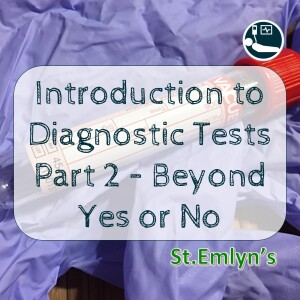
Sunday Jun 15, 2014
Sunday Jun 15, 2014
What is a Diagnosis?
A diagnosis is essentially a label that we put on a patient to indicate what they have, which then guides our treatment decisions. In the ED, our primary focus is on identifying life-threatening conditions. This approach often involves working backwards by first ruling out serious conditions before considering what a patient might actually have.
Initial Diagnostic Approach
As emergency physicians, our initial approach is to use tests with high sensitivity. These tests are designed to pick up anyone who might have the disease. Once we rule out the serious conditions, we look at tests with high specificity to confirm the diagnosis, as treatments often carry risks. For example, therapies such as thrombolysis come with significant risks, so we need to be fairly certain before proceeding, unlike less consequential treatments like wrist splints.
Understanding Probabilities in Diagnoses
When we say a patient has a diagnosis, we’re essentially saying it’s likely enough to treat. Conversely, when we say a patient doesn’t have a diagnosis, we mean it’s unlikely enough to withhold treatment. This probabilistic approach is vital in the ED and can be surprising to many people.
Case Study: Cardiac Chest Pain
Let’s apply this to a patient with cardiac-sounding chest pain. Our goal is to either rule out or confirm the disease and start appropriate treatment. We start with specific tests to rule in a diagnosis, such as an ECG. A positive ECG with significant ST segment changes indicates a high likelihood of disease, warranting immediate treatment. This approach quickly sorts out high-risk patients.
For patients with normal or near-normal ECGs but still concerning symptoms, we need sensitive tests to ensure we don't miss anyone with myocardial disease. About 10% of these patients might have underlying issues, so we need to ensure our tests are sensitive enough to catch these cases.
Using Prevalence and Pre-test Probability
To decide if a patient has the disease, we must consider the prevalence or pre-test probability in our population. For example, in patients with normal ECGs and no alarming history, the pre-test probability might be around 10%. This isn’t low enough to rule out the disease but also not high enough to justify treatment without further testing.
Diagnostic Processes in the ED
We use a step-by-step diagnostic process. Starting with the most specific tests to rule in a diagnosis, we then use sensitive tests like high-sensitivity troponin to rule out diseases. High-sensitivity troponin tests are great for ruling out diseases due to their sensitivity. If the test is negative, we can be confident the patient doesn’t have myocardial damage. If the test is positive but not dramatically high, we may need additional tests to confirm the diagnosis.
Each diagnostic step adjusts our patient’s probability of having the disease. Our goal is to reach a probability low enough to safely rule out the disease or high enough to justify treatment. This process is continuous, and we apply it to every patient, whether they have chest pain or another symptom like a headache.
Understanding Likelihood Ratios
We often use likelihood ratios to interpret diagnostic tests. A positive likelihood ratio increases the probability of the disease, while a negative likelihood ratio decreases it. For example, a high-sensitivity troponin test is excellent at ruling out myocardial infarction because of its high sensitivity, though it’s not as good at ruling in due to lower specificity.
Optimising Diagnostic Tests
Diagnostic tests like troponin can be optimized by adjusting the threshold levels. For instance, a higher threshold might improve specificity and thus be better at ruling in the disease, while a lower threshold improves sensitivity, making it better at ruling out the disease. This principle applies to various tests, including white cell counts and amylase levels.
Continuous Assessment and Reassessment
In the ED, we continuously assess and reassess patients. Each diagnostic step, whether it’s asking a question about symptoms or ordering a lab test, adjusts our understanding of the patient’s condition. This iterative process helps us make informed decisions about treatment and ensures that we don’t miss critical diagnoses.
Applying the Approach to Different Symptoms
This diagnostic approach isn’t limited to chest pain. Whether a patient presents with a headache, abdominal pain, or any other symptom, we apply the same principles of sensitivity, specificity, and likelihood ratios. Each question we ask and each test we perform helps refine our assessment and move closer to a definitive diagnosis.
Conclusion
Mastering diagnostic skills in the ED involves understanding and applying probabilities, using specific and sensitive tests effectively, and continuously reassessing the patient’s condition. By focusing on these principles, we can make more accurate diagnoses, provide appropriate treatments, and ultimately improve patient outcomes.
More listening about diagnosis
Podcast – Diagnosis in Emergency Medicine Part 1 – SpIN and SnOUT
Podcast – Diagnosis in Emergency Medicine Part 2 – Beyond a simple yes or no
Podcast – Diagnosis in Emergency Medicine Part 3 – The importance of prevalence
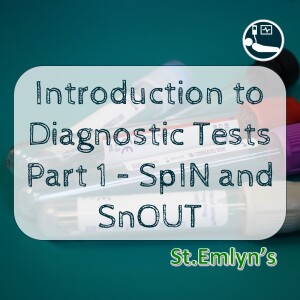
Tuesday Jun 10, 2014
Tuesday Jun 10, 2014
Patients often come to us with the fundamental question: "Doctor, what's wrong with me?" Our goal is to provide an answer through history, examination, and tests. Let's explore what it means to make a diagnosis in emergency medicine.
The Role of Diagnosis in Emergency Medicine
In day-to-day practice, making a diagnosis often means applying a label to a patient. This label helps us decide on the next steps, whether to treat or reassure and send them home. In emergency medicine, we frequently focus on ruling out serious conditions rather than confirming them. This approach allows us to prioritize immediate life-threatening issues and manage resources effectively.
Working Backwards: Ruling Out Serious Conditions
Our primary concern in emergency medicine is to identify conditions that can kill quickly, often within hours. Therefore, we start by ruling out the most serious conditions first. Diagnostic tests, including history and physical examination, play a crucial role in this process. Every question we ask and every examination we perform are part of our diagnostic strategy, aiming to rule out or confirm serious illnesses.
Sensitivity and Specificity in Diagnostic Testing
Understanding diagnostic tests involves two key concepts: sensitivity and specificity.
- Sensitivity refers to a test's ability to correctly identify those with the disease (true positives). High sensitivity means that a negative test result is reliable for ruling out the disease.
- Specificity measures a test's ability to correctly identify those without the disease (true negatives). High specificity means that a positive test result is reliable for confirming the disease.
For example, a D-Dimer test for thrombotic disease is highly sensitive. It picks up most cases of the disease but also includes some false positives. Conversely, a highly specific test like jaw claudication for temporal arteritis has very few false positives but isn't useful as a broad screening tool because only a small percentage of patients with the disease exhibit this symptom.
The Importance of Probability and Risk
In emergency medicine, we rarely achieve 100% certainty in diagnosis. Tests with 98% sensitivity, for instance, still miss 2% of cases. This level of uncertainty is part of our practice, and we must communicate it effectively to patients. Explaining the probabilistic nature of diagnosis helps patients understand the limitations of medical testing and the importance of follow-up if symptoms persist or worsen.
Balancing Diagnosis and Treatment
The consequences of diagnosing and treating a condition vary. For life-threatening conditions like myocardial infarction (MI), the treatment involves significant interventions such as thrombolysis or PCI, which carry their own risks. Therefore, we need a high degree of certainty before initiating such treatments. In contrast, diagnosing a viral sore throat, which requires minimal intervention, demands less certainty.
Continuous Learning and Improvement
Reflecting on our diagnostic processes is crucial for improvement. Recognizing that we work in a probabilistic environment helps us balance the need for thorough investigation with the risk of over-testing. By continuously learning and refining our approach, we can enhance patient care and outcomes.
Favourite Diagnostic Tools
To conclude, let's talk about our favorite diagnostic tools. Personally, I appreciate the value of ultrasound in the resuscitation room, especially for diagnosing pneumothorax in trauma patients. It's a quick, effective tool that guides immediate intervention. Simon, on the other hand, highlights the D-Dimer test. Despite its controversial reputation, it serves as a prime example of a test that, when understood and used correctly, can be incredibly valuable.
We hope this podcast has provided some insight into the complexities and nuances of diagnosis in emergency medicine. Stay tuned for our next episode, where we'll delve deeper into the probabilistic nature of diagnosis and how we make informed decisions in the emergency department. Until then, take care and continue to enjoy your practice in emergency medicine.
More listening about diagnosis
Podcast – Diagnosis in Emergency Medicine Part 1 – SpIN and SnOUT
Podcast – Diagnosis in Emergency Medicine Part 2 – Beyond a simple yes or no
Podcast – Diagnosis in Emergency Medicine Part 3 – The importance of prevalence

Monday Jun 02, 2014
Ep 1 - St.Emlyn's The Podcast - An Introduction
Monday Jun 02, 2014
Monday Jun 02, 2014
Welcome to the St Emlyn's Podcast: A New Chapter in FOAMed
We're thrilled to announce the launch of the St Emlyn's podcast, bringing fresh perspectives and insights from the world of emergency medicine. I'm Iain Beardsell, and alongside Simon Carley, we're excited to extend our reach from the St Emlyn's blog to your favourite podcast platforms.
Why a Podcast?
The landscape of medical education is evolving, and while there's a plethora of excellent podcasts out there, there's a notable gap in UK-centric content. Our aim is to fill that void, offering a unique blend of clinical discussions, evidence-based medicine, and practical management tips tailored for emergency physicians in the UK and beyond.
What is FOAMed?
For those new to the term, FOAMed stands for Free Open Access Medical Education. It's a philosophy we deeply believe in: sharing knowledge, experiences, and lessons to improve patient care globally. FOAMed isn't just about free resources; it's about fostering a community where we can all learn from each other.
What Makes St Emlyn's Podcast Unique?
While we draw inspiration from giants like EMCrit and Scott Weingart, our podcast will provide a distinct UK perspective. Here's what you can expect:
- Evidence-Based Medicine: We'll dive deep into journal appraisals and discuss the latest research, making it relevant to our everyday clinical practice.
- Practical Clinical Tips: As practising clinicians, we bring real-world experience from our busy emergency departments, tackling the challenges we all face.
- Management Insights: Working in high-intensity, high-risk environments, we’ll share strategies on managing departmental flow, dealing with access block, and improving patient outcomes.
Upcoming Episodes
Our first few episodes will focus on diagnosis—a cornerstone of emergency medicine. We'll explore what makes diagnostic tests effective, how to interpret them, and why sometimes we just get lucky. Understanding these elements is crucial for any emergency physician aiming to excel in their field.
Join Our Journey
We’re not just podcasters; we're part of a broader community of emergency medicine professionals. We'll be featuring guests who are experts in their fields, sharing their insights and experiences. These aren't just any guests; they're some of the smartest and most renowned clinicians, who, unbeknownst to them, will soon be part of our podcasting journey.
A Regular Dose of Education
We plan to release episodes regularly, ensuring you have a steady stream of content to enhance your practice. Whether you're commuting, walking the dog, or just relaxing, our podcast will be a valuable addition to your routine.
Stay Tuned
Subscribe to our podcast on iTunes or your preferred platform, and keep an eye on the St Emlyn's blog for more updates. We look forward to embarking on this new journey with you, bringing the best of emergency medicine education to your ears.
Thank you for joining us, and let's make this an engaging and enlightening experience for all.
